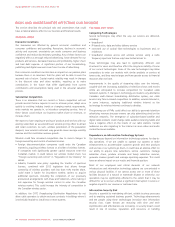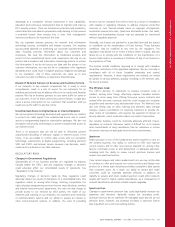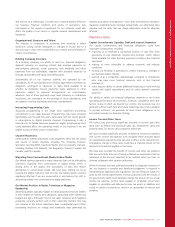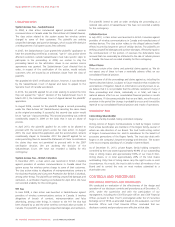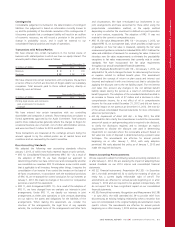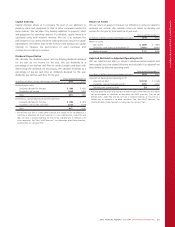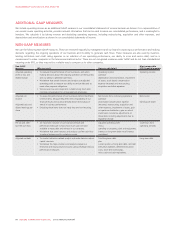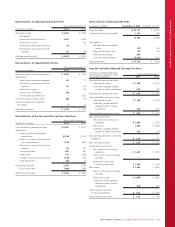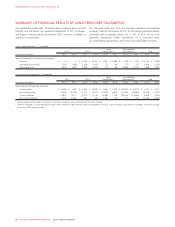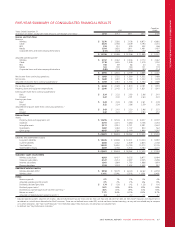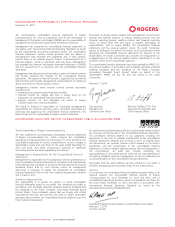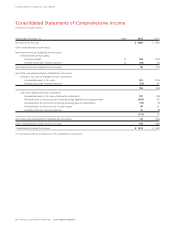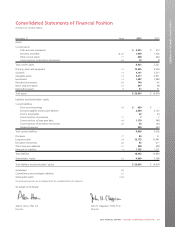Rogers 2013 Annual Report Download - page 88
Download and view the complete annual report
Please find page 88 of the 2013 Rogers annual report below. You can navigate through the pages in the report by either clicking on the pages listed below, or by using the keyword search tool below to find specific information within the annual report.
MANAGEMENT’S DISCUSSION AND ANALYSIS
ADDITIONAL GAAP MEASURES
We include operating income as an additional GAAP measure in our consolidated statements of income because we believe it is a representative of
our normal course operating activities, provides relevant information that can be used to assess our consolidated performance, and is meaningful to
investors. We calculate it by taking revenue and deducting operating expenses, including restructuring, acquisition and other expenses, and
depreciation and amortization as shown in our consolidated statements of income.
NON-GAAP MEASURES
We use the following Non-GAAP measures. These are reviewed regularly by management and our Board in assessing our performance and making
decisions regarding the ongoing operations of our business and its ability to generate cash flows. These measures are also used by investors,
lending institutions and credit rating agencies as an indicator of our operating performance, our ability to incur and service debt, and as a
measurement to value companies in the telecommunications sector. These are not recognized measures under GAAP and do not have standardized
meaning under IFRS, so they may not be a reliable way to compare us to other companies.
Non-GAAP
measure Why we use it How we calculate it Most comparable
IFRSfinancial measure
Adjusted operating
profit or loss and
related margin
• To evaluate the performance of our businesses, and when
making decisions about the ongoing operations of the business
and our ability to generate cash flows.
• We believe that certain investors and analysts use adjusted
operating profit to measure our ability to service debt and to
meet other payment obligations.
• We also use it as one component in determining short-term
incentive compensation for all management employees.
Operating income
add back
depreciation and amortization, impairment
of assets, stock-based compensation
expense (recovery) and restructuring,
acquisition and other expenses
Operating income
Adjusted net
income
Adjusted basic and
diluted earnings per
share
• To assess the performance of our businesses before the effects
of these items, because they affect the comparability of our
financial results and could potentially distort the analysis of
trends in business performance.
• Excluding these items does not imply they are non-recurring.
Net income from continuing operations
add back
stock-based compensation expense
(recovery), restructuring, acquisition and
other expenses, impairment of assets, gain
on spectrum distribution, gain on sale of
investment, income tax adjustments on
these items including adjustments due to
legislative change
Net income
Earnings per share
Pre-tax and after-
tax free cash flow
• An important indicator of our financial strength and
performance because it shows how much cash we have
available to repay debt and reinvest in our company.
• We believe that some investors and analysts use free cash flow
to value a business and its underlying assets.
Adjusted operating profit
minus
spending on property, plant and equipment,
interest on long-term debt net of interest
capitalized
Cash flows from
operating activities
Adjusted net debt • To conduct valuation-related analysis and make decisions about
capital structure.
• We believe this helps investors and analysts analyze our
enterprise and equity value and assess various leverage ratios as
performance measures.
Total long-term debt
plus
current portion of long-term debt, net Debt
Derivatives liabilities, deferred transaction
costs, short-term borrowings,
minus cash and cash equivalents.
Long-term debt
84 ROGERS COMMUNICATIONS INC. 2013 ANNUAL REPORT


